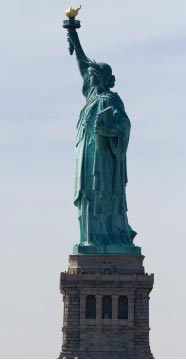A Monumental Task
Lady Liberty gets a post-9/11 makeover
- By Megan Weadock
- Aug 28, 2008
 One of the most chilling aspects of the 2001
attacks on the World Trade Center and the
Pentagon was the terrorists’ choice of targets:
facilities that represent the pinnacle of U.S. security and
prosperity. Striking a blow to two such important icons
was a frighteningly effective way for the extremists to
make their point.
One of the most chilling aspects of the 2001
attacks on the World Trade Center and the
Pentagon was the terrorists’ choice of targets:
facilities that represent the pinnacle of U.S. security and
prosperity. Striking a blow to two such important icons
was a frighteningly effective way for the extremists to
make their point.
Since then, the need to protect U.S. monuments—and
other important American symbols—has become
increasingly clear.
“The events of 9/11 have really changed how people
all over the world conduct their business,” said Capt.
Charles Guddemi of the U.S. Park Police, which provides
law enforcement to areas within the National Park
Service. “There seems to be a higher demand for monument
security today.”
One of the nation’s highest-profile monuments
has always been the Statue of Liberty, which, over
the last few years, has been experiencing a major security
upgrade.
Land of Liberty
The Statue of Liberty is the classic symbol of American
ideals—brazenly illustrating the importance of freedom
in the United States. It is, in essence, a symbol of what
many terrorists seem to hate about America.
“The Statue of Liberty is probably the most visible
American icon,” Guddemi said. “She continues to be the
world’s greatest symbol of freedom. Pretty much as a
result of 9/11, we went under a few different security
assessments [at the statue], and we knew we needed to
improve some of the ways we conducted our security.”
NPS teamed up with ICx Technologies to provide
various security upgrades to both Liberty and Ellis
islands. ICx is an Arlington, Va.-based developer of
advanced sensor technologies for homeland security,
force protection and commercial applications.
Liberty Island and Ellis Island are linked by the Statue
of Liberty tours. Tourists board tour boats at Liberty State
Park in New Jersey and Battery Park in Manhattan, then
visit both Liberty Island, where the statue is located, and
Ellis Island, the famous stop that was the processing point
for millions of immigrants upon their arrival in America.
The island is now home to the Ellis Island Immigration
Museum, a popular historical site.
Best of the Best
Christopher Falkiewicz, senior manager of sales engineering
at ICx and the program manager at the Statue of
Liberty site, said ICx security products now protect visitors,
staff and the facilities themselves at various points
on the tour.
“Over the past 2.5 years, we’ve provided many different
forms of security products and systems for the Statue
of Liberty site,” he said. “In this location, the ICx products
do all types of security detection. Tourists who get
on the tour boats are run through checkpoints featuring
a gamut of the best products in the security industry,
many of which are from ICx.”
As the tour boats approach Liberty Island, they are
monitored by an ICx radar camera system, which senses
and tracks anything coming near the island. The system
includes the ICx DefendIR pan-and-tilt cameras, which
have two heads—a “visible” video camera and a thermal
camera. The dual-head design is critical because thermal
cameras cannot see through certain materials, for example,
glass. With the DefendIR’s Vision Sense technology,
the thermal and visible images can be overlaid, giving
the operator the most information available from both
cameras, both during the day and at night.
“You can have the thermal imaging at night,
you can have a regular camera during the day and then
there’s a mixed version, where you mix the thermal
with the daytime camera and get more of a daytime
view, even of nighttime events,” Falkiewicz said.
“Even at the statue, they can use it as thermal at night
or as mixed, which they use more often. And it’s really
an operator function. They have the ability to select
the view themselves.”
The ICx equipment at the statue also includes explosion
detection, radiological and biological devices for advanced
security. The company also recently installed an access control
and badging system at the Ellis Island location.
Installing the new equipment at one of the country’s
most popular tourist sites was a challenge itself.
“Anything we do at the Statue of Liberty presents
special challenges,” Guddemi said. “She is a colossal
piece of art, and because of the historic nature, the environmental
issues and a lot of logistics, everything we do
has special challenges there.”
Falkiewicz said closing the site was one option ICx
never had.
“We basically had to do it during off hours or early in
the morning before tourists came out,” he said. “We
couldn’t interfere with any of the tourist activity.”
Looking Ahead
Guddemi said having the best and newest technologies at
the Statue of Liberty will always be a priority.
“The new and emerging technologies will continue to
enhance our security plan and create a safer environment
for our visitors, staff and resources,” Guddemi said.
Some security upgrades at the statue are still ongoing.
Falkiewicz said additional ICx projects may
include improved communication systems between
Liberty and Ellis islands, as well as new installations in
other NPS areas.
In the meantime, Lady Liberty, that
iconic symbol of America, is much
more secure and will continue to carry
her torch for many years to come.
This article originally appeared in the issue of .